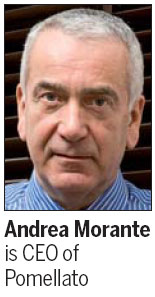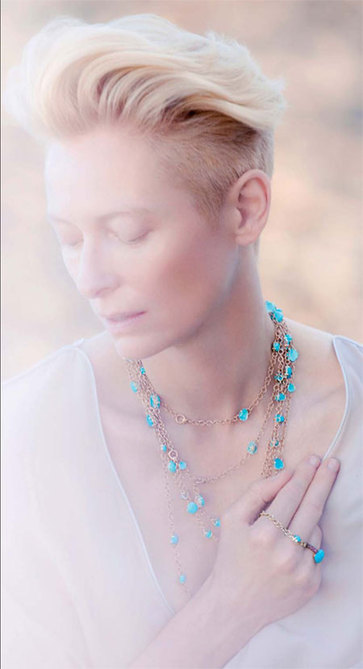Ritzy, not glitzy
Updated: 2012-11-23 09:08
By Xu Junqian (China Daily)
|
|||||||||||
|
British actress Tilda Swinton is the "face" of Pomellato. Provided to China Daily |
Italian jewelry house seeks sophisticated market in China
Despite what Marilyn Monroe sang and millions would have you believe, diamonds are not a girl's best friend, a conference of women leaders was told in Shanghai recently.
Sure, they can be beautiful to look at, can shine and be a bit blue at times, but there's nothing special or unusual about them and all this coming from the head of one of Europe's top jewelry houses.
Andrea Morante, CEO of Pomellato, said in his keynote speech to the Women in Leadership Forum China in September that the diamond-less, non-glitzy approach was the one his company took when it formed 45 years ago and still pursues today when designing and selling jewelry.
It is also a philosophy and strategy that is especially significant when it comes to competing in the new luxury market of China.
Pomellato is credited with introducing pret-a-porter jewelry when it was founded in 1967 by Pino Rabolini, whose family still holds the majority share in the company. To take on and outshine the established diamond-studded likes of Cartier and Tiffany, it innovated jewelry for everyday wear and not just for formal occasions, without compromising quality, exclusivity and cost.
Now, Pomellato is the fifth-largest jeweler in Europe based on sales, with the Financial Times describing it as "Italy's best-kept secret".
Morante, a former investment banker who moved into the luxury industry in the 1990s following his involvement in a Gucci acquisition and restructuring case, puts Pomellato's success to looking at everything from a woman's perspective.
Female customers account for about 75 percent of sales.
"We made the decision that women are our customers," he says. "Although we know that men are very important, and we know that men are very important buyers of jewelry for their lovers. For their lovers, they are huge buyers."
 |
Morante took charge of the Milan-based company in 2009, when the global financial crisis wiped millions of euros off jewelry sales, putting some houses into debt.
That year, Pomellato grossed 100 million euros ($127.6 million) of sales with a percentage profit of up to 16 percent. It is expected it will end 2012 with sales up to 151 million euros, with a 9.7 percent year-on-year growth.
In China, Pomellato is still a new name on the scene, the company only opening its first store less than two years ago in Beijing, and although growth has slowed here in the industry, Morante says the outlook is "extremely promising".
It has since opened another store in Shanghai and a point of sale in Hangzhou.
He acknowledges that, like most luxury companies, the main strategy is to increase presence by gradually opening more stores. At what rate, will "depend on the response from customers and the evolution of the market".
Within the next five years, he says, Pomellato plans to open six or seven stores in China, and 16 points of sale in other outlets. This would match the company's current presence in the United States, its biggest overseas market.
According to the National Bureau of Statistics of China, in 2011 the jewelry business posted 183.7 billion yuan (23.1 billion euros; $29.4 billion) in retail sales, up 42.1 percent from the year before. In comparison, total retail sales of all goods in the country rose 17.1 percent.
Morante said there are mixed fortunes to Pomellato's late arrival in China.
"To find the right locations here you have to come really early," he says, and getting the "absolute best location" has been the main challenge, with many other luxury brands already on the scene.
"But because our products need a bit of time for the market to appreciate, I think this is the perfect time for us, in terms of market acceptance of Pomellato."
Gold and diamonds are popular, especially with the strong gift-giving tradition in China, because they show recipients that money has been invested and instantly demonstrate worth.
"But that type of market is significantly different from what we represent," Morante says. "So we have to wait until perhaps Chinese women have travelled a bit, read more, and also become more style-conscious.
"With other products, if demand for them increases dramatically, you can organize and satisfy the additional demand. That is very difficult for us. We are by definition exclusive.
"But this market (China) is so significant and so important that we have to continue to invest."
Morante describes Pomellato jewelry as being designed for successful women - "not necessarily" the rich and famous, or beautiful. He defines the collection, sold between 1,500 euros and 7,000 euros a piece, as a "style" product, instead of a "status" product.
He names Charlotte Casiraghi, princess of Monaco, as a prime example of a customer.
"She has nothing to prove, nothing to explain about her status. She dresses Pomellato, without even consulting us, because she goes for style, and she feels comfortable with that."
The current "face" of Pomellato is Tilda Swinton, the British actress known for her roles in both arthouse and mainstream movies. She is the professional and independent modern woman that the company believes its clientele identify with.
Other "strategic moves" include a commitment to the environment, which Morante says has captured the interest of younger customers.
When the company introduced their DoDo brand, named after the extinct bird, 18 years ago, it decided that for every piece of jewelry sold, a percentage of the price would go to the World Wildlife Fund.
"We are doing this because we thought more attention should be paid to sustainability and to the balance of the Earth," Morante says.
Morante believes those sentiments will be increasingly shared by Chinese customers for jewelry and luxury goods over the next decade as they become more worldly and sophisticated.
xujunqian@chinadaily.com.cn
(China Daily 11/23/2012 page21)
Today's Top News
Rescuers race against time for quake victims
Telecom workers restore links
Coal mine blast kills 18 in Jilin
Intl scholarship puts China on the map
More bird flu patients discharged
Gold loses sheen, but still a safe bet
US 'turns blind eye to human rights'
Telecom workers restore links
Hot Topics
Lunar probe , China growth forecasts, Emission rules get tougher, China seen through 'colored lens', International board,
Editor's Picks

|

|

|

|

|

|






